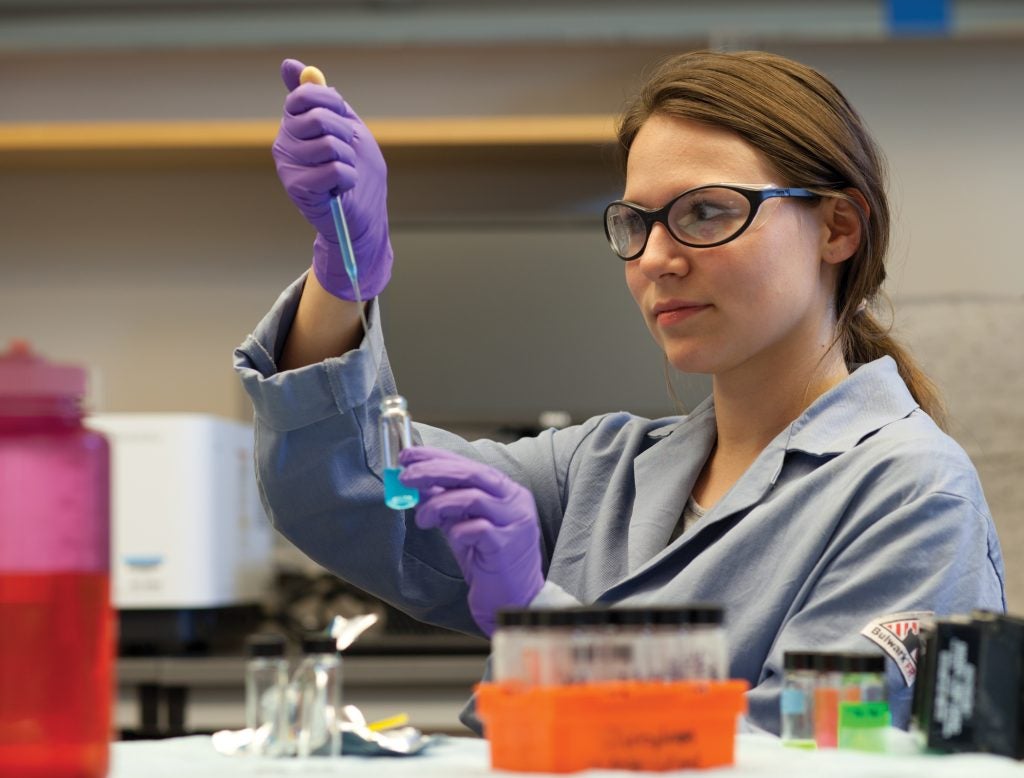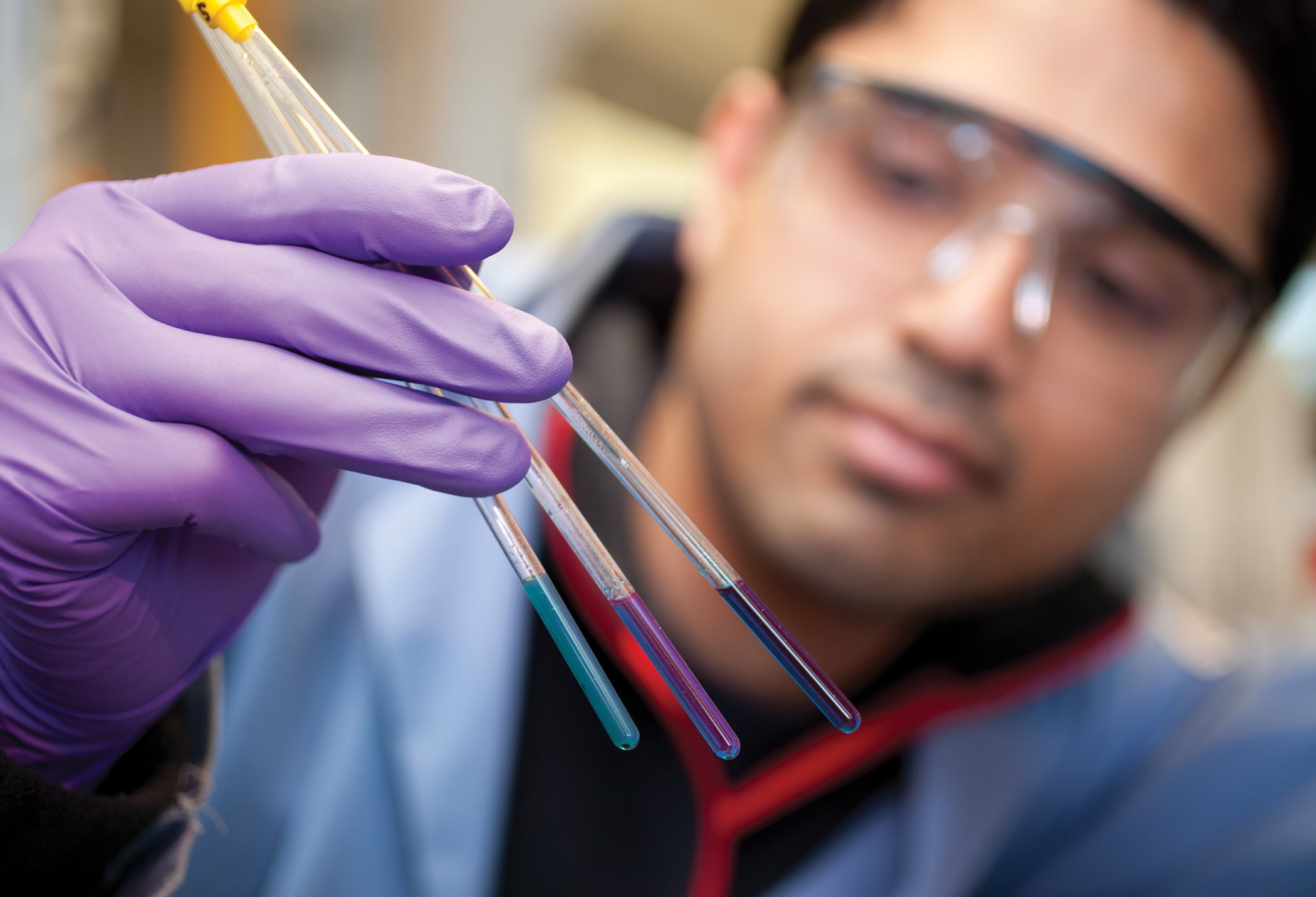Oil spills, cardiovascular disease, and beverage safety don’t sound like related fields of study, but they all fall under the research spectrum of URI chemist Mindy Levine.
As safety concerns around commercial products continue to grow, lengthy testing processes are currently the only way to know if what we put into our bodies is safe. Levine, an associate professor in the Department of Chemistry, is researching fast, efficient and on-site testing methods for our food and beverages.
“I don’t want to spend my whole life in my lab playing with chemicals. I want to do something that is relevant and will help people,”Mindy Levine
The chemist and her students are studying several critical research questions, through the lens of supramolecular organic chemistry. Her research examines how to apply the fundamental science of fluorescence spectroscopy to enable high-impact detection applications.
Levine investigates how fluorescence, which gives off a unique, highly specific and highly sensitive signal, can be used to detect specific chemicals in complex environments. The fundamental nature of her research allows her to apply the detection technology to find answers to many questions.
Fluorescence indicators that change color in the presence of toxic chemicals
One issue that intrigues Levine is how we know if our food and beverages are safe for consumption. Despite the wealth of technology chemists have access to, she says they have yet to develop a method to crudely assess on-site whether harmful chemicals have leached into food or water.
Levine says when she microwaves her leftovers to eat for lunch in a plastic container, or finds a plastic water bottle in her sweltering car after a long day at the beach, she wants to know if the food or water is safe to consume without having to take it to her lab for testing.
These questions led Levine to apply her research for the study of rapid Bisphenol A (BPA) detection technology. There is significant concern among scientists that long-term BPA exposure may cause harmful health effects. Now in the second year of a five-year $650,000 National Science Foundation grant, she is exploring the fundamental science that underlies sensor applications that could detect dangerous chemicals, like BPA, in food and water. One of her goals is to develop a smartphone app that could detect harmful chemicals by reading a test strip people would dip into their food or beverages.

This technology is merely one application of her research. The most accurate way to think of her research, according to Levine, is as developing fundamental science and a key detection technique for the detection of many different types of chemicals in many different environments. “We are really tool makers,” she says.
Currently, Levine is applying for grants to support the application of her research for the breath detection of cardiovascular disease and for the detection of marijuana in saliva. She also is developing, through a grant from the National Cancer Institute, carcinogen detection technology, and she just finished a grant from the Rhode Island Research Alliance that enabled her to research the detection of pesticides in Rhode Island waterways.
Levine received $213,816 in funding from the Gulf of Mexico Research Initiative in 2012 to detect traces of oil left in surrounding waters from the 2010 Deepwater Horizon Oil Spill. With the grant money, her team developed safe and effective ways to catalyze organic chemistry reactions to change toxic oil molecules into non-toxic molecules. In the fall of 2016, Levine received the Stanley Israel Award for Increasing Diversity in the Chemical Sciences, an award granted by the American Chemical Society.

“It is our job, and a moral imperative, that when we are successful in science, we turn around and help other people be successful as well. Science is a really hard field and so, for the sake of science and anybody who is in this field, we should be doing everything we can to ensure that every person who has the interest, ability, and motivation to go into science is able to do so.”Mindy Levine
Levine is particularly passionate about championing the effort to attract more women to science. She runs several programs, including a science camp every April school vacation for middle school girls, and a Sugar Science Day where high school girls conduct experiments with sugar.
Levine came to URI in 2010 from Massachusetts Institute of Technology, where she was a National Institutes of Health funded postdoctoral fellow for two years. She received her undergraduate and graduate degrees from Columbia University. Though her work holds many applications outside academia, mentoring research students is part of her calling.
“I could never get talked out of the fact that I could come up with any crazy idea in my head and tomorrow there could be a student in the lab running an experiment I designed to test that idea,” Levine says. “That intellectual freedom is amazing.”
Story originally printed in Momentum: Research & Innovation, a publication of the Vice President for Research and Economic Development, with editorial, graphic design and production by the Office of University Research External Relations.
